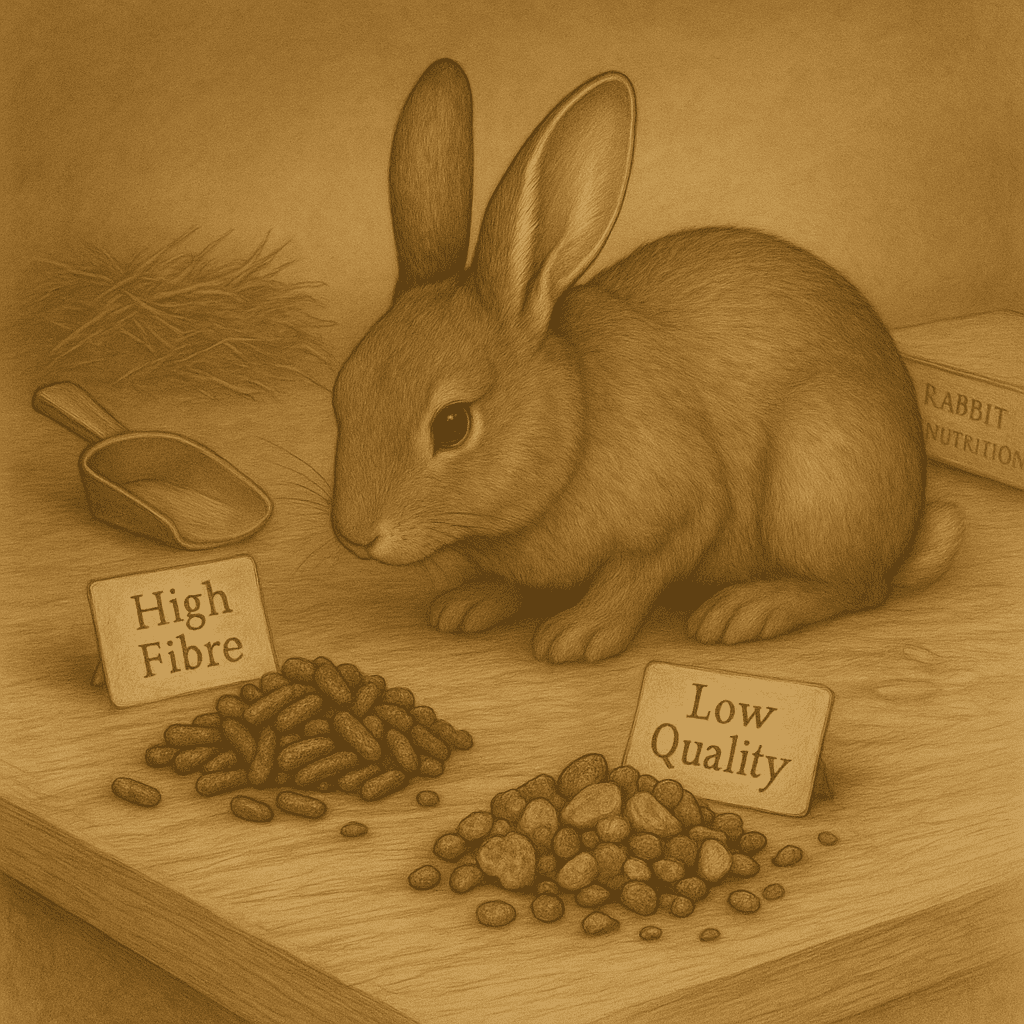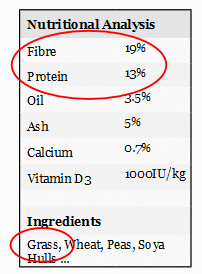Rabbit Pellets: What You Should Know

Introduction:
Rabbit pellets are not all created equal.
While marketing often promises “balanced nutrition” or “vet approved” formulas, the reality is that many commercial pellets are unsuitable for long-term rabbit health. High levels of starch, sugar, and low-quality fillers can quietly undermine gut function and lead to serious problems, including obesity, dental disease, and gastrointestinal stasis.
Choosing the right pellet — and feeding it correctly — is a crucial part of responsible rabbit care.
This guide outlines what really matters when evaluating pellets, and why forage — not processed food — must remain the foundation of a rabbit’s diet.
At Redbeck, we feed high-quality, fibre-rich pellets as part of our boarding care. Our standard options include Science Selective Adult and Burgess Excel Adult formulations — both chosen for their appropriate nutritional profiles to support healthy gut function and overall wellbeing.
The Problem with Marketing Claims
Many commercial rabbit pellets are designed to appeal to owners, not to meet the true nutritional needs of rabbits.
Bright packaging, vague terms like “natural” or “healthy,” and claims of being “suitable for all life stages” often hide poor-quality formulations.
Common marketing tactics include:
- Highlighting added vitamins and minerals while ignoring poor base ingredients.
- Promoting “gourmet” blends that mix pellets with dried fruits, seeds, or colourful treats — all inappropriate for healthy rabbits.
- Using vague terms like “high in fibre” without specifying actual fibre content.
True quality is not found on the front of the bag.
It is found in the small print:
- The fibre percentage.
- The ingredient list.
- The balance of critical nutrients.
Rabbits evolved to thrive on a diet of tough, fibrous plants, not processed grain-based feeds.
When evaluating a pellet, the question is simple:
Does this product support a rabbit’s digestive physiology — or fight against it?
Marketing is noise.
Composition is truth.

What Nutritional Values Matter
When evaluating rabbit pellets, certain nutritional targets must be non-negotiable.
These are based on the biological needs of the rabbit’s gastrointestinal system — not marketing claims or cosmetic additions.
Key nutritional guidelines:
- Fibre:
- Minimum 18%, preferably closer to 22–25%.
- Fibre is essential for gut motility, caecal health, and prevention of stasis.
- Protein:
- Adult maintenance: 12–14%.
- Slightly higher protein (16–18%) may be appropriate for growing kits, pregnant, or lactating does.
- Fat:
- Low fat content, ideally between 2–3%.
- High fat promotes obesity and caecal dysbiosis.
- Calcium and Phosphorus:
- Balanced ratio of calcium to phosphorus, ideally around 1.5–2:1.
- Excess calcium can predispose to urinary stones; deficiency can weaken bone and dental health.
- Carbohydrates:
- Minimal simple sugars or starches.
- Grains, molasses, and dried fruits should not feature prominently.
These values are not arbitrary.
They reflect what the rabbit’s gut and metabolism are designed to process — and what they are destroyed by when neglected.

What Ingredients to Look For
The ingredient list reveals the real quality of any rabbit pellet — not the branding, not the promises on the front.
When evaluating ingredients, focus on what appears first.
Ingredients are listed in order of weight, so the first few items dominate the nutritional profile.
What you want to see:
- Grass hays (such as timothy, meadow, or orchard grass) listed first.
- Dried grass or forage-based products as primary ingredients.
- Minimal or no added sugars, molasses, or sweeteners.
What you want to avoid:
- Cereals (wheat, corn, oats, barley) listed ahead of fibre sources.
- By-products like middlings, hulls, or unspecified “plant materials.”
- Artificial colours, flavours, or preservatives — unnecessary and sometimes harmful.
- “Muesli-style” mixes that encourage selective feeding and poor nutritional balance.
Golden rule:
If a pellet relies on cereals to form its base, it is not a true herbivore feed — no matter how attractively it is marketed.
Grass-based, high-fibre pellets are not treats.
They are the only processed feed a rabbit should ever need — and even then, only in strict moderation.

How Much Should Rabbits Eat?
Even the best-quality pellet is no substitute for natural forage — and overfeeding pellets can be just as harmful as choosing the wrong type.
Guidelines for adult rabbits:
- Pellets should form a small part of the daily diet — no more than an egg-cup full per day for an average-sized adult rabbit (roughly 20–25g).
- The bulk of the diet must be unlimited grass hay, supplemented with a variety of fresh leafy greens.
- Pellets should not replace hay. They should support it by providing consistent baseline nutrients.
Common mistakes to avoid:
- Over-relying on pellets instead of offering constant hay.
- Using pellets as treats — rabbits should not be “bribed” with processed food.
- Feeding muesli mixes — these allow selective feeding, leading to dangerous nutrient imbalances.
Young, growing rabbits, pregnant does, and rabbits recovering from illness may require slightly adjusted portions and formulations.
For healthy adults, less is better.
A rabbit should graze, not gorge.

Important Note on Pellet Quantities
Portion guidelines for rabbit pellets — such as the “egg-cup rule” — are based on the assumption that rabbits have unlimited access to high-quality hay and fresh forage.
Pellets alone cannot meet a rabbit’s fibre, hydration, or nutritional needs.
If hay and forage are not available, simply limiting pellets can lead to chronic malnutrition, weight loss, gut dysfunction, and ultimately starvation.
In these cases, the priority must be restoring hay intake immediately.
Where hay is absent and cannot yet be replaced, pellet portions must be increased temporarily to prevent life-threatening deficiencies — but this is a rescue measure, not proper diet management.
A rabbit’s health depends not on pellet quantity alone, but on the structure of the entire diet.
Closing Note
Choosing the right pellet is not about chasing marketing trends.
It is about understanding the biology of the rabbit — a grazing herbivore designed for a high-fibre, low-energy diet.
Pellets can support health when carefully selected and fed in moderation.
They can also undermine it when overfed, poorly composed, or relied upon as a dietary mainstay.
The goal is not to feed what looks good on a bag.
It is to feed what keeps the rabbit’s gut moving, its teeth healthy, and its body strong.
When in doubt, always return to the basics:
Fibre first. Hay always. Pellets wisely.
A healthy rabbit is a grazing rabbit.

References
- Harcourt-Brown, F. (2002). Textbook of Rabbit Medicine. Butterworth-Heinemann.
- Meredith, A., & Lord, B. (2014). BSAVA Manual of Rabbit Medicine. British Small Animal Veterinary Association.
- Jenkins, J. R. (1999). Dietary considerations for rabbits. Veterinary Clinics of North America: Exotic Animal Practice, 2(2), 339–355.
- House Rabbit Society (HRS). Feeding your rabbit: The importance of fibre. Retrieved from www.rabbit.org
- Rabbit Welfare Association & Fund (RWAF). (2021). Rabbit nutrition guidelines.
Copyright © Redbeck Rabbit Boarding. This article is free to share with credit. No part may be copied, edited, or republished without permission.
